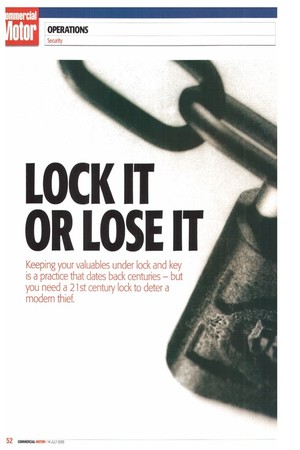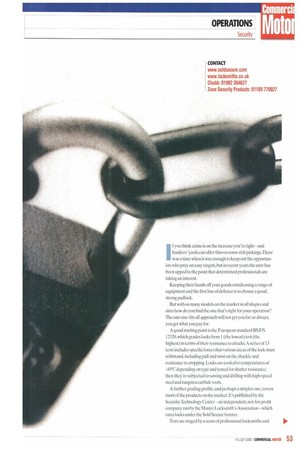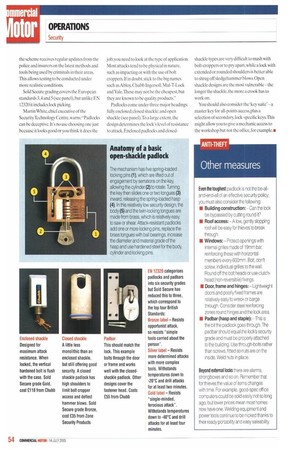LOCK IT OR LOSE IT
Page 52

Page 53

Page 54

If you've noticed an error in this article please click here to report it so we can fix it.
Keeping your valuables under lock and key is a practice that dates back centuries — but you need a 21st century lock to deter a modern thief.
If you think crime is on the increase you're right— and hauliers' yards can offer thieves some rich pickings.There was a time when it was enough to keep out the opportunists who prey on easy targets, but in recent years the ante has been upped to the point that determined professionals are taking an interest.
Keeping their hands off your goods entails using a range of equipment and the first line of defence is to choose a good. strong padlock.
But with so many models on the market in all shapes and sizes how do you find the one that's right for your operation? The one-size-fits all approach will not get you far; as always, you get what you pay for.
A good starting point is the European standard BS EN 12320, which grades locks from [(the lowest) to 6 (the highest) in terms of their resistance to attacks. A series of 13 tests includes specific forces that various areas of the lock must withstand, including pull and twist on the shackle and resistance to cropping. Locks are cooled to temperatures of -40°C depending on type and tested for shatter resistance; then they're subjected to sawing and drilling with high-speed steel and tungsten carbide tools.
A further grading profile, and perhaps a simpler one, covers most of the products on the market. It's published by the Security Technology Centre—an independent, not-for-profit company run by the Master Locksmith's Association —which rates locks under the Sold Secure banner.
Tests are staged by a team of professional locksmiths and the scheme receives regular updates from the police and insurers on the latest methods and tools being used by criminals in their areas. This allows testing to be conducted under more realistic conditions.
Sold Secure grading covers the European standards 3,4 and 5 (see panel), but unlike EN 12320 it includes lock picking.
Martin While, chief executive of the Security Technology Centre, warns: Padlocks can be deceptive. It's no use choosing one just because it looks good or you think it does the job; you need to look at the type of application. Most attacks tend to be physical in nature, such as impacting or with the use of bolt croppers. If in doubt, stick to the big names such as Abloy, Chubb Ingersoll, Mul-T-Lock and Yale.These may not be the cheapest, but they are known to be quality products."
Padlocks come under three major headings: fully enclosed; closed shackle: and open shackle (see panel).To a large extent, the design determines the lock's level of resistance to attack. Enclosed padlocks and closed shackle types are very difficult to mash with bolt-croppers or to pry apart, while a lock with extended or rounded shoulders is better able to shrug off sledgehammer blows. Open shackle designs are the most vulnerable—the longer the shackle, the more a crook has to work on.
You should also consider the 'key suite' —a master key for all-points aecess,plus a selection of secondary, lock-specific keys. This might allow you to give a mechartic access to the workshop but not the office, for example.•










































































































































































































